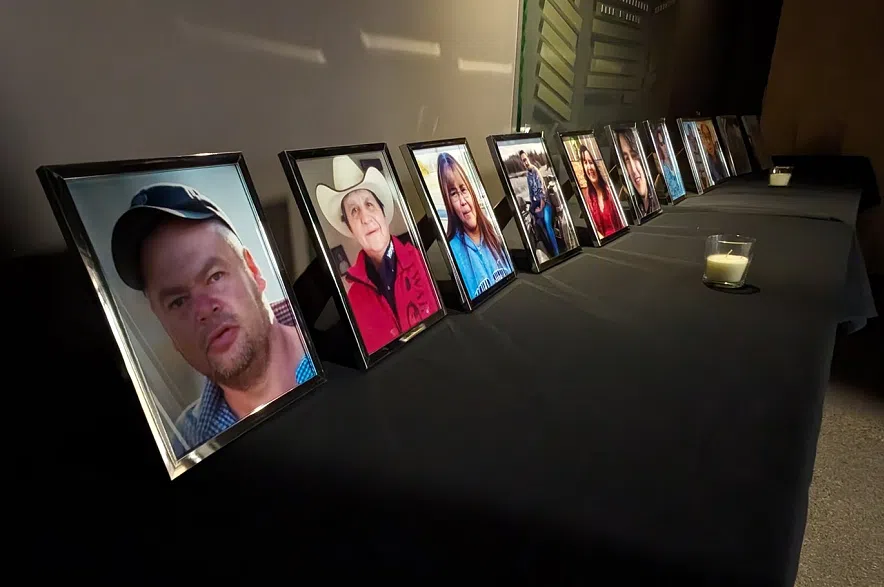After 11 days of testimony and just over a day of jury deliberations, the inquest into the mass murders on the James Smith Cree Nation and in Weldon is over.
On Wednesday in Melfort, the six-member jury returned with 29 recommendations it hopes can prevent incidents like Myles Sanderson’s stabbing rampage on Sept. 4, 2022.
Sanderson killed 11 people and injured 17 others in the attacks.
The jury recommended to the Correctional Service Canada that:
- Where feasible, it assign to offenders a consistent individual like an Elder or community parole officer who can provide continuity as they progress through their time spent in a specific facility or a specific community on conditional release;
- It hires more Elders in all federal correctional centres;
- Program availability, as well as the number of ongoing programs, be increased to reduce the caseload on faciliators and Elders;
- An increased focus by the assigned parole officer be designated to locating offenders through contacts within the first month of them being deemed unlawfully at large; and
- The community parole officer should follow up with the offender’s access to medical care to ensure the offender is receiving support and accessing appropriate medical care upon release.
The jury recommended to the RCMP that:
- Any photo of an individual on a police database or police access tool must display the date of the photo in a prominent way; and
- It be mandatory to provide more resources to specialized RCMP teams such as the drug enforcement team to dedicate more services to apprehending individuals involved in the trafficking of drugs.
To the James Smith Cree Nation, the jury recommended that:
- Current community programming be evaluated and programming related to addictions and substance abuse, victim services, adverse childhood experiences, domestic or intimate partner violence, traditional parenting as well as programming for children be considered;
- A community resource package or brochure be made and distributed to all community members and offenders being released back to the James Smith Cree Nation;
- It be mandated that all houses should have house numbers posted on the front of the buildings in an easily visible location as well as street signs be installed for all roadways, and that mapping be updated and distributed to all Emergency Services as well;
- That the community continues to provide further funding and training to the James Smith Cree Nation Security Force to ensure the safety and security of all within the community;
- Leadership should continue to follow through on the process started of establishing the James Smith Cree Nation police force in a prompt and timely fashion; and
- It and the RCMP should collaborate on attendance at community events, such as ceremonies and celebrations to foster positive relations and trust between the two parties.
To the federal Ministry of Public Safety, the jury recommended that a national alerting system be established on a platform where the public can sign in to receive alerts, and that a dangerous person alert category be created on that system.
Presiding coroner Blaine Beaven also took the opportunity to make more than a dozen of his own recommendations.
He called on the RCMP to: Expand the Warrant Enforcement Suppression Team, Crime Reduction Team and Saskatchewan Trafficking Response Team; to adopt best practices and technologies to make available to patrol officers the most current photo of a suspect; and to make repeat domestic offenders more of a target for officers.
Beaven also suggested the leadership of the James Smith Cree Nation canvass members of the community about a wanted community member when police are looking for that person, and to promote the timely and accurate reporting of crime to police or to Crime Stoppers.
For Correctional Service Canada, he recommended that offenders with a history of domestic violence be required to complete programming specific to breaking the cycle of domestic violence prior to release, that it tell police with jurisdiction over a First Nation if a warrant has been issued for a person from that community, that it should fill Elder and other staffing vacancies in correctional facilities, and that it provide programming that will enable support persons to provide a healthy and successful environment for the offender to be released into.
“It’s been an extraordinarily difficult few weeks,” Beaven said. “It’s been difficult for the jury, it’s been difficult for the counsels and that pales completely in comparison to the difficulty that must have been felt by the survivors of the attacks, the families, of those involved and the community at large.
“This inquest is a forward-looking process and despite the challenges that we faced in this inquest emotionally, there is a hope that I have that something positive will come out of this tragedy and these recommendations will be followed or considered and we will see positive change in society and prevent future similar deaths.”
READ MORE:
- Day 1: Jury selection, first witness at James Smith Cree Nation inquest
- Day 2: Emotions intensify as testimony continues at JSCN inquest
- Day 3: RCMP witness at JSCN inquest discusses drug trade, warrants
- Day 4: RCMP witness apologizes to veteran’s family at JSCN inquest
- Day 5: Psychologist shares assessment of Myles Sanderson at JSCN inquest
- Day 6: Inquest hears Sanderson wasn’t among Sask.’s most wanted before attacks
- Day 7: Sanderson’s release from custody scrutinized at JSCN inquiry
- Day 8: Parole officers, program facilitator detail Sanderson’s progress in prison
- Day 9: Psychologist offers apologies to families during JSCN inquest
- Day 10: Pathologist tells inquest EMS likely couldn’t have saved murder victims
- Day 11: Elders describe dealings with Sanderson in prison
- JSCN families share their hopes for inquest recommendations
The recommendations will be taken by the Saskatchewan Coroners Service and forwarded to those to whom the recommendations were made, such as the RCMP or Correctional Service Canada.
The coroners service will check back periodically to see how the institution is doing on the recommendations. However, the implementation of the recommendations that come out of a coroner’s inquest isn’t mandatory.
When Beaven charged the jury Tuesday, he told the members they would have to determine the official cause, date, place and manner of death. On Wednesday, their findings matched the evidence that two pathologists gave during the inquest.
But the jurors also were tasked with coming up with recommendations on how to prevent similar tragedies — and family members and First Nations leaders indicated they wanted to hear about things like Indigenous policing, programming in prison, and programming in the community.
The inquest, which began Jan. 15, heard from more than 30 witnesses, including first responders, psychologists, psychiatrists, forensic pathologists and officials from the Parole Board of Canada and Correctional Service Canada.
Some of those who interacted Sanderson in the criminal justice system described him as a thoughtful and remorseful inmate when he was in prison, while others said he would be a risk to society if released due to his criminal history and history of domestic violence.
Sanderson was given statutory release after serving two-thirds of his sentence in a federal prison. Despite breaching the conditions of his release twice, he was set free both times.
After his third breach, in May of 2022, Sanderson wasn’t in custody again until after the attacks on Sept. 4.
Sanderson was arrested Sept. 7 after RCMP officers ran him off the road near Rosthern. He went into what police called “medical distress” after being arrested and later died in a Saskatoon hospital.
A week-long inquest into Sanderson’s death is to begin Feb. 26 in Saskatoon.











